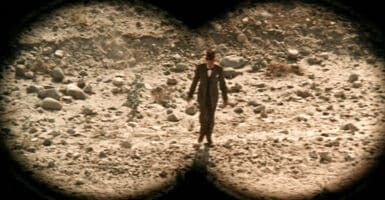Astronomers Track Russian Meterorite’s Point Of Origin
This article is more than 2 years old

If you still haven”t heard about the Russian meteor episode that happened last week, what kind of a non-hurtling-through-space rock are you living under? As shocking, scary, cautionary, and surreal as the video footage is, I was almost more astounded by the technology of dashboard cameras being driven by the fact that Russians are apparently really sketchy drivers. That sounds like profiling.
An entirely different kind of data mining was done by astronomers Jorge Zuluaga and Ignacio Ferrin from the University of Antioquia in Medellin, Columbia. They calculated the orbit of the meteorite for a study titled “A preliminary reconstruction of the orbit of the Chelyabinsk Meteoroid,” which has not been peer-reviewed as of yet. They watched all the various videos online, choosing the two best suited to their task of calculating a rough trajectory, also taking into account the large ice hole left in Lake Chebarkul that was supposedly caused by the meteorite.
In order to determine the meteorite’s orbit around the sun and figure out where it came from, the researchers used the “brightening point” of the rock — whenever it becomes bright enough for its shadow to be seen in the videos — to estimate its height, elevation, velocity, and the azimuth at the brightening point, among other things.
“According to our estimations, the Chelyabinski meteor started to brighten up when it was between 32 and 47 km up in the atmosphere,” the study states. “The velocity of the body predicted by our analysis was between 13 and 19 km/s (relative to the Earth) which encloses the preferred figure of 18 km/s assumed by other researchers.”
Using the Naval Observatory Vector Astrometry (NOVAS) software, the team input all of their known data and concluded that the meteoroid almost definitely came from the common class of Apollo asteroids that regularly pass through Earth’s orbit. Though the results are preliminary, Suluaga and Ferrin are hard at work making sure their information is verifiable and correct. Even though this wasn’t some long-awaited solution to a big mystery, it’s still an amazing example of how far we’ve come as a species, and how much Russian driving skills factor into astronomical identification.
A less technical website with all of the relevant information can be found here.












